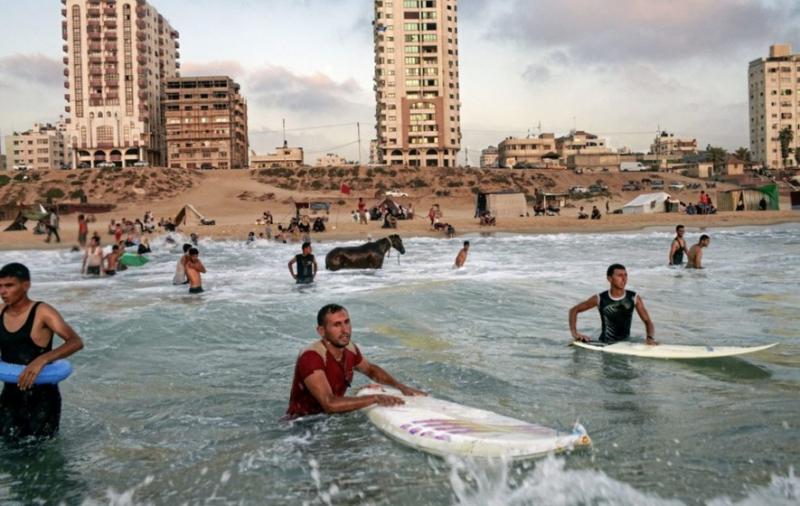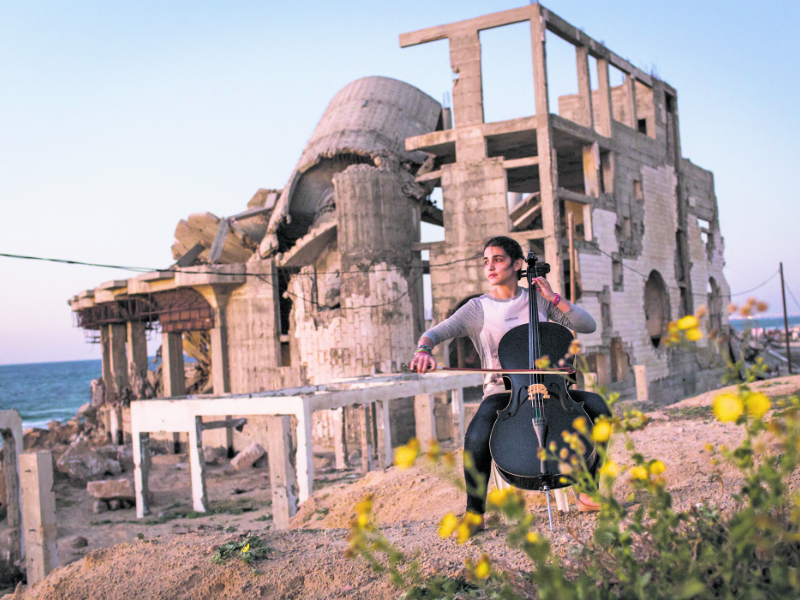Gaza review - portraits of love and futility | reviews, news & interviews
Gaza review - portraits of love and futility
Gaza review - portraits of love and futility
Sundance-screened doc shows locals' lives in close and troubling detail

First-time collaborators Garry Keane and Andrew McConnell have tried to divert from the standard media narrative by looking at Gaza from the viewpoint of its inhabitants.
There is a free-floating and casual mood to this film. The creators’ mission is clear: to sit back and let the people speak. For most of the film, we witness the ordinary, often mundane details of everyday life in the 25-mile long settlement. We glide past lively street market scenes, beach activities, fishing boats and card tables. The mischief and adventure of young children can be heard in the background. But tension always looms in the form of rifled guards, a waving Hamas flag or a distant rocket flare. The film’s production certainly involved tensions. Keane and McConnell were filming in Gaza when the conflict of May 14 2018 erupted, in which 60 protestors were killed. The directors accumulate an impressive cross-section of life. We meet a cab driver, a fashion designer, a theatre director, a lifeguard, and a 14-year-old boy, all vastly different and yet bound by the cruelty of historical chance. The people talk openly about their interests and dreams. Keane and McConnell capture the human frustrations borne by political imbecility. Everyone feels stifled by debt, shortages and war. A local tailor can only operate his sewing machines for four hours a day due to electricity cuts. A dressmaker is forced to decline overseas invitations to exhibit her work. Whilst the interviews evoke great sympathy, the “characters” here do not to want merely to be pitied. They want their stories to help create change.
The directors accumulate an impressive cross-section of life. We meet a cab driver, a fashion designer, a theatre director, a lifeguard, and a 14-year-old boy, all vastly different and yet bound by the cruelty of historical chance. The people talk openly about their interests and dreams. Keane and McConnell capture the human frustrations borne by political imbecility. Everyone feels stifled by debt, shortages and war. A local tailor can only operate his sewing machines for four hours a day due to electricity cuts. A dressmaker is forced to decline overseas invitations to exhibit her work. Whilst the interviews evoke great sympathy, the “characters” here do not to want merely to be pitied. They want their stories to help create change.
In the film’s final third, there is a sharp turn. The focus shifts from the intimate interview format to more general, fractured footage of conflict at the borders. Victims are carried to ambulances. Family members weep among chaotic crowds. A man crouches in the rubble of what must have been his home. These are compelling images, but tonally it is difficult to reconcile with the calm, observant mood of the film’s prior interview-portraits.
However, the film’s central mission holds out, as we are returned to the suffering of the inhabitants and their strength and dignity in the face of turmoil. “When will it end?” wonders Karma, a law student who aspires to win a scholarship to study overseas. No one can know. Only hope, we are shown, can allow the people of Gaza to abide uncertainty.
The future of Arts Journalism
You can stop theartsdesk.com closing!
We urgently need financing to survive. Our fundraising drive has thus far raised £49,000 but we need to reach £100,000 or we will be forced to close. Please contribute here: https://gofund.me/c3f6033d
And if you can forward this information to anyone who might assist, we’d be grateful.

Subscribe to theartsdesk.com
Thank you for continuing to read our work on theartsdesk.com. For unlimited access to every article in its entirety, including our archive of more than 15,000 pieces, we're asking for £5 per month or £40 per year. We feel it's a very good deal, and hope you do too.
To take a subscription now simply click here.
And if you're looking for that extra gift for a friend or family member, why not treat them to a theartsdesk.com gift subscription?
more Film
 The Mastermind review - another slim but nourishing slice of Americana from Kelly Reichardt
Josh O'Connor is perfect casting as a cocky middle-class American adrift in the 1970s
The Mastermind review - another slim but nourishing slice of Americana from Kelly Reichardt
Josh O'Connor is perfect casting as a cocky middle-class American adrift in the 1970s
 Springsteen: Deliver Me From Nowhere review - the story of the Boss who isn't boss of his own head
A brooding trip on the Bruce Springsteen highway of hard knocks
Springsteen: Deliver Me From Nowhere review - the story of the Boss who isn't boss of his own head
A brooding trip on the Bruce Springsteen highway of hard knocks
 The Perfect Neighbor, Netflix review - Florida found-footage documentary is a harrowing watch
Sundance winner chronicles a death that should have been prevented
The Perfect Neighbor, Netflix review - Florida found-footage documentary is a harrowing watch
Sundance winner chronicles a death that should have been prevented
 Blu-ray: Le Quai des Brumes
Love twinkles in the gloom of Marcel Carné’s fogbound French poetic realist classic
Blu-ray: Le Quai des Brumes
Love twinkles in the gloom of Marcel Carné’s fogbound French poetic realist classic
 Frankenstein review - the Prometheus of the charnel house
Guillermo del Toro is fitfully inspired, but often lost in long-held ambitions
Frankenstein review - the Prometheus of the charnel house
Guillermo del Toro is fitfully inspired, but often lost in long-held ambitions
 London Film Festival 2025 - a Korean masterclass in black comedy and a Camus classic effectively realised
New films from Park Chan-wook, Gianfranco Rosi, François Ozon, Ildikó Enyedi and more
London Film Festival 2025 - a Korean masterclass in black comedy and a Camus classic effectively realised
New films from Park Chan-wook, Gianfranco Rosi, François Ozon, Ildikó Enyedi and more
 After the Hunt review - muddled #MeToo provocation
Julia Roberts excels despite misfiring drama
After the Hunt review - muddled #MeToo provocation
Julia Roberts excels despite misfiring drama
 London Film Festival 2025 - Bradley Cooper channels John Bishop, the Boss goes to Nebraska, and a French pandemic
... not to mention Kristen Stewart's directing debut and a punchy prison drama
London Film Festival 2025 - Bradley Cooper channels John Bishop, the Boss goes to Nebraska, and a French pandemic
... not to mention Kristen Stewart's directing debut and a punchy prison drama
 Ballad of a Small Player review - Colin Farrell's all in as a gambler down on his luck
Conclave director Edward Berger swaps the Vatican for Asia's sin city
Ballad of a Small Player review - Colin Farrell's all in as a gambler down on his luck
Conclave director Edward Berger swaps the Vatican for Asia's sin city
 London Film Festival 2025 - from paranoia in Brazil and Iran, to light relief in New York and Tuscany
'Jay Kelly' disappoints, 'It Was Just an Accident' doesn't
London Film Festival 2025 - from paranoia in Brazil and Iran, to light relief in New York and Tuscany
'Jay Kelly' disappoints, 'It Was Just an Accident' doesn't
 Iron Ladies review - working-class heroines of the Miners' Strike
Documentary salutes the staunch women who fought Thatcher's pit closures
Iron Ladies review - working-class heroines of the Miners' Strike
Documentary salutes the staunch women who fought Thatcher's pit closures
 Blu-ray: The Man in the White Suit
Ealing Studios' prescient black comedy, as sharp as ever
Blu-ray: The Man in the White Suit
Ealing Studios' prescient black comedy, as sharp as ever

Add comment